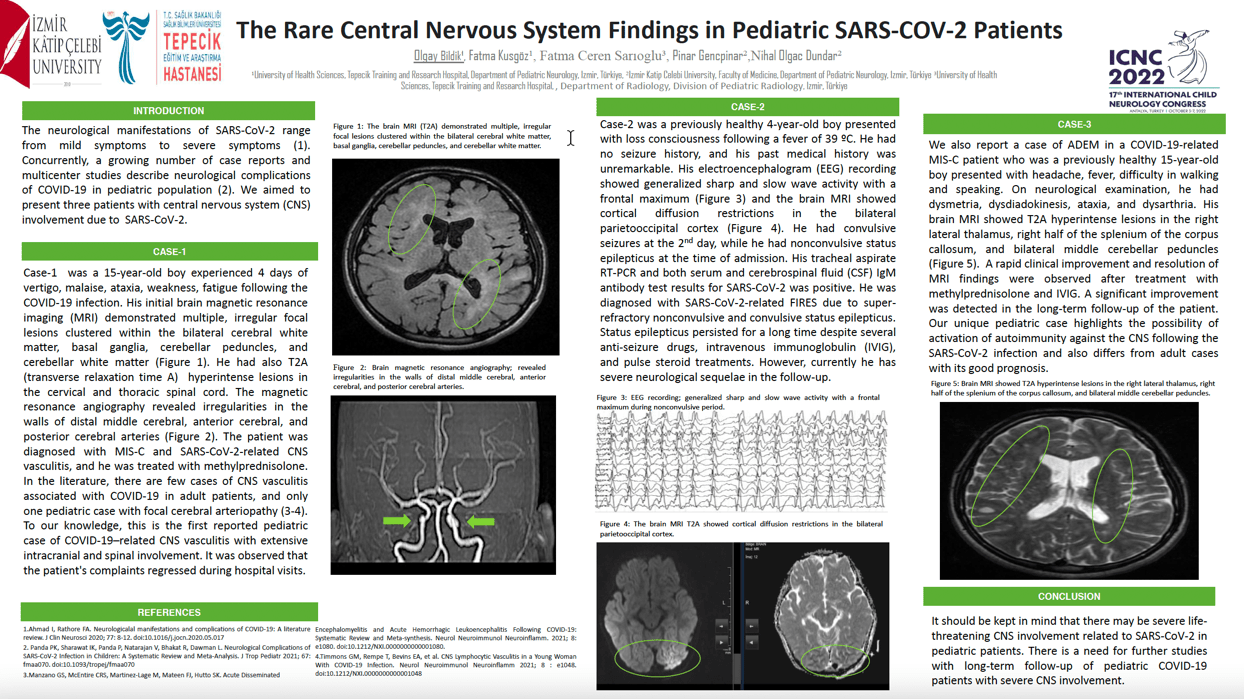The Rare Central Nervous System Findings in Pediatric SARS-COV-2 Patients
OLGAY BILDIK, GUNCE BASARIR, FATMA KUSGOZ, FATMA CEREN SARIOĞLU, PINAR GENCPINAR, NIHAL OLGAC DUNDAR
Objective: The neurological manifestations of SARS-CoV-2 range from mild symptoms to severe symptoms. We aimed to present three patients with central nervous system (CNS) involvement due to SARS-CoV-2. Case presentation: Case 1 was a previously healthy 4-year-old boy presented with loss consciousness following a fever of 39 ºC. His electroencephalogram recording showed generalized sharp and slow wave activity with a frontal maximum. He was diagnosed with SARS-CoV-2-related febrile infection-related epilepsy syndrome (FIRES) due to super-refractory nonconvulsive status epilepticus. Status epilepticus persisted for a long time despite several anti-seizure drugs, intravenous immunoglobulin (IVIG), and pulse steroid treatments. Case 2 was a COVID-19-related acute disseminated encephalomyelitis (ADEM) patient who was a previously healthy 15-year-old boy presented with fever, difficulty in walking and speaking. His brain MRI showed T2A hyperintense lesions in the right lateral thalamus, right splenium of the corpus callosum, and bilateral middle cerebellar peduncles. A rapid clinical improvement and resolution of MRI findings were observed after treatment with methylprednisolone and IVIG. Case 3 was a 15-year-old boy experienced 4 days of vertigo, ataxia, fatigue following the COVID-19 infection. The magnetic resonance angiography revealed irregularities in the walls of distal middle cerebral, anterior cerebral, and posterior cerebral arteries. The patient was diagnosed with SARS-CoV-2-related CNS vasculitis, and he was treated with methylprednisolone. Conclusion: İt should be kept in mind that there may be severe life-threatening CNS involvement related to SARS-CoV-2 in pediatric patients. There is a need for further studies with long-term follow-up of pediatric COVID-19 patients with severe CNS involvement.
Keywords: COVID-19; SARS-CoV-2; neurological findings; pediatric
OLGAY BILDIK
University of Health Sciences, Tepecik Training and Research Hospital
Turkey
GUNCE BASARIR
University of Health Sciences, Tepecik Training and Research Hospital
Turkey
FATMA KUSGOZ
University of Health Sciences, Tepecik Training and Research Hospital
Turkey
FATMA CEREN SARIOĞLU
University of Health Sciences, Tepecik Training and Research Hospital
Turkey
PINAR GENCPINAR
Izmir Katip Celebi University, Faculty of Medicine
Turkey
NIHAL OLGAC DUNDAR
Izmir Katip Celebi University, Faculty of Medicine
Turkey
Objective: The neurological manifestations of SARS-CoV-2 range from mild symptoms to severe symptoms. We aimed to present three patients with central nervous system (CNS) involvement due to SARS-CoV-2. Case presentation: Case 1 was a previously healthy 4-year-old boy presented with loss consciousness following a fever of 39 ºC. His electroencephalogram recording showed generalized sharp and slow wave activity with a frontal maximum. He was diagnosed with SARS-CoV-2-related febrile infection-related epilepsy syndrome (FIRES) due to super-refractory nonconvulsive status epilepticus. Status epilepticus persisted for a long time despite several anti-seizure drugs, intravenous immunoglobulin (IVIG), and pulse steroid treatments. Case 2 was a COVID-19-related acute disseminated encephalomyelitis (ADEM) patient who was a previously healthy 15-year-old boy presented with fever, difficulty in walking and speaking. His brain MRI showed T2A hyperintense lesions in the right lateral thalamus, right splenium of the corpus callosum, and bilateral middle cerebellar peduncles. A rapid clinical improvement and resolution of MRI findings were observed after treatment with methylprednisolone and IVIG. Case 3 was a 15-year-old boy experienced 4 days of vertigo, ataxia, fatigue following the COVID-19 infection. The magnetic resonance angiography revealed irregularities in the walls of distal middle cerebral, anterior cerebral, and posterior cerebral arteries. The patient was diagnosed with SARS-CoV-2-related CNS vasculitis, and he was treated with methylprednisolone. Conclusion: İt should be kept in mind that there may be severe life-threatening CNS involvement related to SARS-CoV-2 in pediatric patients. There is a need for further studies with long-term follow-up of pediatric COVID-19 patients with severe CNS involvement.
Keywords: COVID-19; SARS-CoV-2; neurological findings; pediatric
OLGAY BILDIK
University of Health Sciences, Tepecik Training and Research Hospital
Turkey
GUNCE BASARIR
University of Health Sciences, Tepecik Training and Research Hospital
Turkey
FATMA KUSGOZ
University of Health Sciences, Tepecik Training and Research Hospital
Turkey
FATMA CEREN SARIOĞLU
University of Health Sciences, Tepecik Training and Research Hospital
Turkey
PINAR GENCPINAR
Izmir Katip Celebi University, Faculty of Medicine
Turkey
NIHAL OLGAC DUNDAR
Izmir Katip Celebi University, Faculty of Medicine
Turkey

OLGAY BILDIK
University of Health Sciences, Tepecik Training and Research Hospital Turkey
University of Health Sciences, Tepecik Training and Research Hospital Turkey